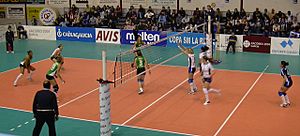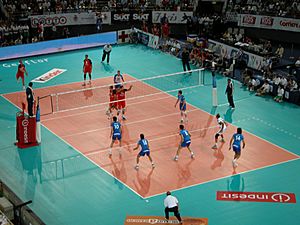Volleyball facts for kids
Volleyball is an exciting team sport. Two teams play on a court divided by a tall net. Each team has six players on the court at one time. They also have up to twelve extra players called substitutions.
The game begins with a coin toss. This decides which team serves the ball first. It also decides which side of the court each team will start on. The main goal of volleyball is to keep the ball in the air. Players can hit the ball with any part of their body. However, a team can only touch the ball three times before sending it over the net. If the ball touches the floor on your side, the other team scores a point.
Contents
History of Volleyball
In 1895, a man named William G. Morgan created a new game. He called it "Mintonette." An observer, Alfred Halstead, watched the game. He saw how players "volleyed" the ball back and forth over the net. So, he suggested changing the name to "volleyball."
Morgan wanted a game that needed more players than basketball. He also wanted it to use less space and be less tiring. The first net was a simple rope. The first ball was an air bladder from a basketball. Until 1960, men and women played with different rules. Now, the rules are mostly the same. The only difference is the net height. The men's net is higher.
How to Play Volleyball
A player cannot hit the ball twice in a row. A team scores a point when the ball lands inside the opponent's court. This happens if the other team cannot hit it back legally. The ball must always be served (hit) from outside the court. If it's served from inside, it's a foul.
Volleyball games are played in sets. Most sets go up to 25 points. Sometimes, they go to 21 points. The first team to reach the target score wins the set. To win a set, a team must be ahead by at least 2 points. If the score is 24-24, for example, the game continues until one team leads by two points (like 26-24).
A full game usually has 3 to 5 sets. In middle school, the first team to win 3 sets wins the game. If the game goes to a fifth set, that set is played to 15 points. Again, the winning team must be ahead by 2 points.
Players often wear knee pads. These protect their knees from bruises. Players might dive to save the ball from hitting the floor.
The main group that controls volleyball worldwide is the Fédération Internationale de Volleyball (FIVB).
Volleyball Court and Positions
The volleyball court is about 60 feet long and 30 feet wide. A net stretches tightly across the middle. The net height is different for different players. For middle school, high school, and college women, it is about 7 feet, 4 inches high. For college men, it is about 7 feet, 11 inches high.
Players on the court rotate their positions. They move in a clockwise direction after their team wins the serve. There are six main positions on the court:
- Position 1: Back right side of the court. This is where the server stands.
- Position 2: Front right side of the court, near the net.
- Position 3: Middle of the front court, right next to the net.
- Position 4: Front left side of the court, near the net.
- Position 5: Back left side of the court.
- Position 6: Middle of the back court.
Scoring in Volleyball
Volleyball uses "rally scoring." This means a point is given to one of the two teams after every rally. A rally ends when the ball hits the floor or a mistake is made.
A standard game is played to 25 points. The winning team must be ahead by 2 points. In middle and high school, games are often played as the best out of three sets. If the teams are tied 1-1 after two sets, the third set is played to 15 points. The winning team still needs to be ahead by 2 points.
Key Skills in Volleyball
Volleyball involves several important skills:
Serving
Serving is how you start a rally. You hit the ball from behind the end line.
- Underhand Serve: The player swings their arm underhand to hit the ball.
- Overhand Serve: The player swings their arm overhand to hit the ball.
- Float Serve: Like a "knuckleball" in baseball. The server hits the ball without much spin. This makes the ball wobble and change direction in the air.
- Top Spin Serve: The server snaps their wrist hard when hitting the ball. This puts a forward spin on the ball, making it drop faster.
- Jump Serve: The server jumps before hitting the ball. This gives them more height and a better angle to hit the ball down into the opponent's court. It can be a float or topspin serve.
Passing or Bumping
This is used when the ball comes to a player below their shoulders.
- You hold your hands together and keep your elbows straight.
- You hit the ball with your forearms.
- Your shoulders should face the net when you hit the ball.
- A "dig" is a type of pass used for very hard hits.
- A "pancake" is a special dig. The player dives and slides their hand flat under the ball. This makes the ball pop straight up off their hand.
Setting or Volleying
This is an overhead pass used to direct the ball to a specific spot.
- Players hold their hands high with bent elbows.
- They contact the ball with their fingertips.
- They use their legs and arms to push the ball into the air.
Hitting or Spiking
This is a hard hit ball from above the net. It is aimed straight down into the opponent’s side.
- Players hit the ball with cupped fingers and a long arm swing.
Blocking
This is a defensive move.
- Players jump with both hands above their head.
- They reach for a ball that has been spiked by the opponent.
- A block tries to stop the ball from crossing the net.
Digging
Digging is the ability to stop the ball from touching your court. This is especially true after a strong spike or attack. It's often used when the ball is very close to the ground. Players might dive or throw themselves towards the ground to save the ball.
Volleyball Words to Know
- Serve: To put the ball into play from the end line.
- Side out: When the team that served makes a mistake. The ball then goes to the other team to serve.
- Set: An overhead pass that helps a player spike the ball.
- Bump: An underhand pass used when the ball is below the shoulders.
- Spike: A hard hit ball aimed at the opponents' court.
- Block: A defensive play to stop the ball from crossing the net.
- Double: When a player touches the ball twice in a row, usually while setting. This is a foul.
Images for kids
-
A scene of playing Volleyball of the village Naldahari in India
-
Japanese American women playing volleyball, Manzanar internment camp, California, ca. 1943
-
A Spanish player, #18 in red outfit, about to spike towards the Portuguese field, whose players try to block the way
See also
 In Spanish: Voleibol para niños
In Spanish: Voleibol para niños


















